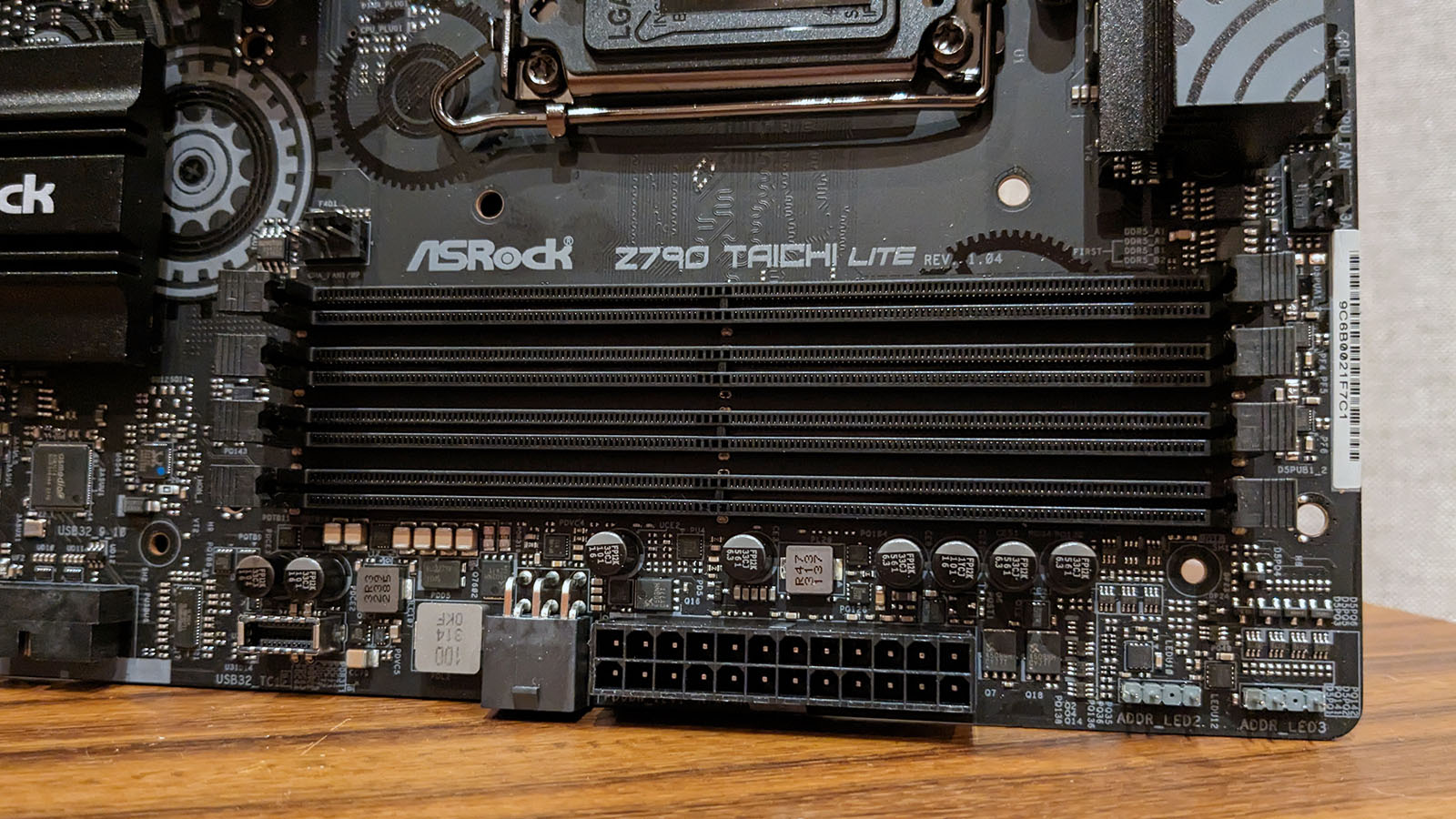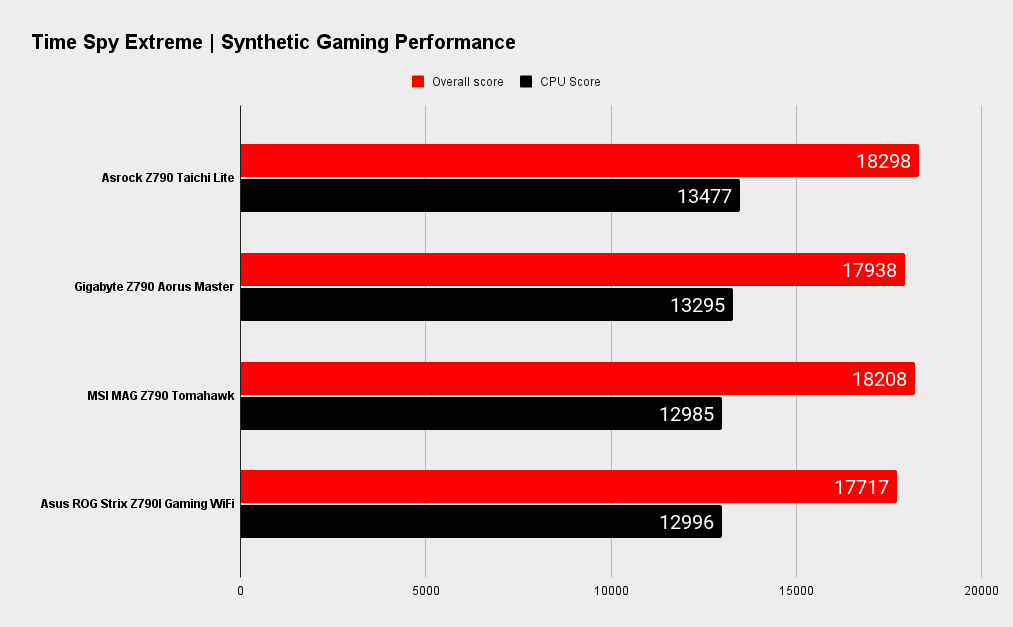Our Verdict
The ASRock Z790 Taichi omits unnecessary bling in favor of what really matters: Features. The result is a motherboard that offers excellent value for money that nothing in its price range can match.
For
- Excellent value for money
- Dual Thunderbolt 4 ports
- A VRM to handle anything you care to throw at it
- Plenty of storage potential
Against
- Basic look won't appeal to all
- No 5G LAN
PC Gamer's got your back
Unlike some years, this year's Computex tech show wasn't one packed full of motherboard highlights. A few vendors showed off prototype Z790 refresh boards for the upcoming Raptor Lake refresh, but it was ASRock's Z790 and B650E Taichi Lite motherboards that got my attention.
It retains all of the features of its non-Lite counterpart, but drops the premium aesthetic, knocking $100 off the price in the process.
The concept behind the ASRock Z790 Taichi Lite I have here for review is simple. It retains all of the features of its non-Lite counterpart, but drops the premium aesthetic, knocking $100 off the price in the process.
ASRock says the admittedly lovely cogs-and-wheels styling of the $479.99 Z790 Taichi costs a lot to make. I totally understand if you have a glass-sided case and want to show off your build, but once you add a graphics card, a large air cooler or water tubing, much of the board gets hidden. That's if you can see it at all. Many users with closed cases will not.
Historically, I've been impressed by Taichi boards. They made their debut in the mid 2010's during an era of RGB overload and seemingly every product had the word 'gaming' attached to it. ASRock's Taichi range bucked that trend with a typically excellent blend of affordability, a simple black and white aesthetic, and a solid feature set.
In recent years, ASRock has elevated the Taichi brand to the flagship tier. Their cyberpunk aesthetic with its cogs and wheels and retro analogue kind of styling looks fantastic, but it also added to their prices, so in many ways the Taichi Lite is a return to the early days of the brand.
Looks aside, the Z790 Taichi Lite retains all of the premium features of the Z790 Taichi. Its long feature list includes dual Thunderbolt 4 Type-C ports, high-end audio and VRM solutions, lots of storage capacity and dual LAN. There's no other motherboard in the Z790 Taichi Lite's price range that ticks all of those boxes.
ASRock Z790 Taichi Lite overview and specs







The Z790 Taichi Lite still has some RGB lighting. The white printed cogs and wheels combined with a primarily black design is not ugly, but it does give it a mid tier, almost utilitarian appearance. But you're anything like me and value function over form and value for money over excessive bling, this is a board that should appeal.

Socket: Intel LGA 1700
CPU compatibility: Intel 12th & 13th Gen desktop processors
Form factor: EATX
Memory support: DDR5-7200+(OC), Up to 192GB
Storage: 5x M.2, 8x SATA
USB: Up to 2x USB4/TB4, 1x USB 3.2 Gen 2x2, 2x USB 3.2 Gen 2, 10x USB 3.1 Gen 1, 6x USB 2.0
Display: 1x HDMI 2.1
Networking: Killer 2.5G LAN, Intel 1G LAN, Killer Wi-Fi 6E
Audio: Realtek ALC4082
Price: $379 / £TBA / AU$TBA
The Z790 Taichi Lite is an E-ATX board with plenty of highlights. You get a total of eight fan headers making this a water-cooling friendly board. Just below the bottom M.2 heatsink is a series of RGB LEDs, and there are four more RGB headers too, three of which are addressable. The board itself may be a little plain, but the ingredients are still there if you wish to light up a fully featured build.
You'll note the presence of a 6-pin power connector adjacent to the front USB 3.2 Gen 2x2 port. Connecting power to it gives the front port 60W fast charging support. Without it, the port is limited to 27W.
You get dual PCIe 5.0 x16 slots and support for up to 192GB of DDR5 at 7200MHz. The Wi-Fi card looks a bit unsightly, but that will be hidden underneath a graphics card, so it's not a concern.
The board comes with five M.2 slots, though only four can be used at a time. That might seem odd, but the twin primary slots can be used with either a PCIe 4.0 or a PCIe 5.0 drive. It means a PCIe 4.0 drive can benefit from the enlarged heatsink, while leaving the PCIe 5.0 x16 slot at full speed. When the PCIe 5.0 M.2 slot is populated, the primary x16 slot drops to x8.
It's all a little confusing once you start populating lots of slots, so it's well worth checking the motherboard manual before buying the Z790 Taichi Lite (or any Z790 board for that matter).
The board also comes with eight SATA ports. That's becoming increasingly rare. Add them to the M.2 slots and you've got a ton of storage potential.

The VRM is a real highlight. It's a 24-phase design with 105A stages cooled by big chunky heatsinks. The Z790 Taichi Lite will happily power a liquid nitrogen cooled Core i9 13900K without breaking a sweat, and it'll handle any upcoming refreshed K model under the same conditions.
Moving on to the connectivity options, the Z790 Taichi Lite has a feature set that exceeds anything else in its price range. Beginning with the rear I/O, the highlight is the dual USB 4/Thunderbolt 4 ports. They support 27W PD and display connectivity. They are joined by two USB 3.2 Gen 2 ports, six USB 3.2 Gen 1 ports and a pair of USB 2.0 ports.
The audio section is top notch. A Realtek ALC4082 codec is matched with an ESS Sabre 9218 DAC and WIMA capacitors. It'll be hard to find a better integrated solution.
The networking capabilities of the board are a bit hit and miss depending on what you need. Intel WiFi 6E is joined by Killer E3100G 2.5G and Intel I219-V 1G wired LAN ports. These will appeal to those requiring dual LAN, but I'd like to see 5G, if not 10G. This would give you high speed SSD NAS support. I do understand Asrock's thinking behind including dual LAN over a single faster port though.
ASRock Z790 Taichi Lite performance
System Performance






Gaming Performance





ASRock Z790 Taichi Lite analysis

The Z790 Taichi Lite is built around a now mature platform. Engineers have had time to optimize PCB layouts, while the underlying BIOS microcode has a couple of years of bug fixes and tweaks behind it. This means Z790 boards should perform within a margin of error of one another.
For previous LGA 1700 testing, I have set the test CPU to Intel's default settings. In the case of an i9 13900K, this would mean a 125W PL1, 253W PL2 and 56 second Tau, however, this is a fiddly thing to set, with several settings to change and submenus to navigate. That's something most users won't want to delve into, so starting with the Z790 Taichi, I've left it and the other boards in the graphs above to their default settings. It's not ideal from a heat and power consumption perspective, and motherboard makers do take liberties, but it best reflects the out of the box performance of a given motherboard.
Onto the results then. The Z790 Taichi Lite throws up no surprises. It puts up good multithreaded results and its PCMark results and 3DMark Storage score show it to be a good all-rounder. There's little to worry about when it comes to gaming either.
CPU: Intel Core i9 13900K
Graphics: Nvidia GeForce RTX 4090 Founders Edition
RAM: 2x 16GB G.Skill Trident Z5 DDR5-6000 C30
Storage: 2TB Seagate FireCuda 530
Cooling: Cooler Master PL360 Flux 360mm AIO
PSU: Corsair AX1000
I generally skip CPU overclocking these days. Cooling is by far the limiting factor and with a top spec VRM like that of the Z790 Taichi Lite, it would reveal nothing about the board itself. I did note the VRM heatsinks were quite warm under default settings while looping Cinebench. With a 60°C reported temperature, some airflow is definitely recommended.
Fast memory needs a well-optimized trace layout and BIOS. I was able to boot 2x 24GB of G.Skill DDR5-7200 at 7600MHz, though doing so requires excessive IMC voltage. My CPU just doesn't handle very high memory speeds that well. It's a trait I have seen with many boards. I think I'll need to plug a Raptor Lake refresh chip in to see if I can pass DDR5-8000. From what I hear, it'll be a lot easier, and the Z790 Taichi Lite is a board I'm sure will happily pair well with one of these future CPUs.
ASRock Z790 Taichi Lite verdict

✅ You're after a great Intel motherboard: The ASRock Taichi Lite has all the hallmarks of a high-end gaming motherboard without any of the unnecessary bling.
✅ You want to max out CPU and memory: The excellent VRM means you have the power to push your processor and RAM to their limits.
❌ You REALLY want that RGB aesthetic touch on all your components: the plain PCB lacks flashy looks, but has all the connections to still create a floodlit rig.
The ASRock Z790 Taichi Lite is a refreshing change in a market that has seen nothing but price increases over the last few years. Spending $500 on a motherboard before even considering a GPU, memory and CPU is a tough pill to swallow when you can get a console for a fraction of the overall price. I really hope other motherboard manufacturers sit up and take notice. Sometimes less really is more.
It's a board that's packed with high end hardware. Apart from 10G LAN and some extras like a PCIe M.2 add-in card or integrated LCD, there's really not that much more to add. And boards that do have those things are definitely not priced at $379.
I really hope other motherboard manufacturers sit up and take notice. Sometimes less really is more.
If you value function over form, the Z790 Taichi Lite is one of the best options out there. It's a flagship tier board without any unnecessary bloat that in many cases, becomes entirely useless once the case side panel is shut. Put simply, there is nothing else out there that offers what Z790 Taichi Lite does.
I am pleased that ASRock has somewhat returned to the Taichi's roots. Its rich feature set, less emphasis on costly aesthetics and great price are traits I'm all too happy to see. It's easy to highly recommend the ASRock Z790 Taichi Lite.
At the time of writing, only the US pricing has been announced. This review will be updated once UK and AU pricing and availability are confirmed.
The ASRock Z790 Taichi omits unnecessary bling in favor of what really matters: Features. The result is a motherboard that offers excellent value for money that nothing in its price range can match.

Chris' gaming experiences go back to the mid-nineties when he conned his parents into buying an 'educational PC' that was conveniently overpowered to play Doom and Tie Fighter. He developed a love of extreme overclocking that destroyed his savings despite the cheaper hardware on offer via his job at a PC store. To afford more LN2 he began moonlighting as a reviewer for VR-Zone before jumping the fence to work for MSI Australia. Since then, he's gone back to journalism, enthusiastically reviewing the latest and greatest components for PC & Tech Authority, PC Powerplay and currently Australian Personal Computer magazine and PC Gamer. Chris still puts far too many hours into Borderlands 3, always striving to become a more efficient killer.


